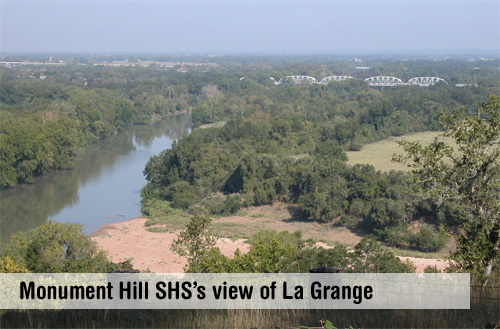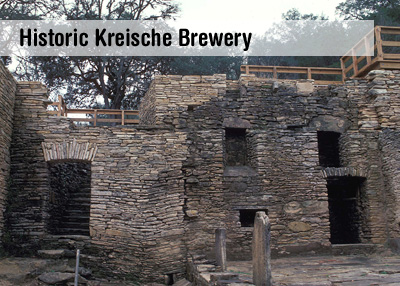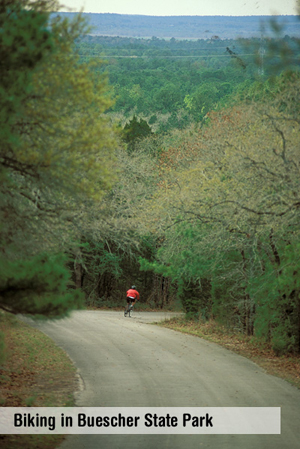Looking for a Quick Getaway?
Destination: La Grange
By Elaine Robbins

Travel time from:
Austin - 1 hour /
Brownsville - 5 hours /
Dallas - 3.75 hours /
El Paso - 10.75 hours /
Houston - 1.75 hours /
San Antonio - 2 hours /
Lubbock - 7.75 hours
Elaborately painted churches offer insights into the La Grange/Schulenberg area’s German/Czech heritage.
The fertile farm fields south of La Grange offer surprising discoveries to the savvy traveler. You’ll be driving along a two-lane country road, lulled by the sight of fat cows grazing blissfully in pastures blooming with wildflowers, and you’ll come upon a neat whitewashed church, its steeple stark against a bright blue sky. From the outside, it looks like any other country church, with its quiet cemetery and community hall. But open the doors, and you’ll see interior walls and ceilings painted in German and Czech folk art styles. The painted churches are the highlights of a journey back to an earlier time of European immigration. Set just a few miles apart on a loop that’s an easy drive from Houston, Austin and San Antonio, the painted churches offer one of the most pleasant road trips in Texas.
The first time I visited one of the painted churches, for the annual polka mass at St. Mary’s Church in High Hill, the red-brick Gothic Revival exterior didn’t prepare me for the riot of sound and color inside. Eighteen stained-glass windows led up toward a vaulted ceiling painted in gold and turquoise. Up at the altar, a cluster of men and women in their 70s and 80s were singing hymns to a rousing polka — dressed in cherry-red outfits and glittery dime-store crowns.
After the mass was over, the parishioners streamed outside, and the polka band set up under a covered pavilion. We stood in line to be served plates of fried chicken, sauerkraut and German potatoes. Then we ate at long tables while people danced to the oom-pah sounds of the polka band.
I asked parishioner Richard Gabler, 80, about the people who attended services at High Hill. “Very few of the younger people speak German now,” he said. “Germans used to marry Germans. When a German marries a Czech, their children don’t learn German.” Then he grinned and confessed to being an early offender himself. “I went to Ammansville when I wasn’t supposed to,” he says, referring to the tiny community nearby where he met his Czech wife. “I’ve been in trouble for the last 65 years.”
On this trip, I’m returning with a friend to see the painted churches and to search for vestiges of the cultures that German, Czech and Wendish immigrants brought to Texas in the 1800s. From La Grange, we head south on Highway 77 to Ammansville. Or what is left of Ammansville. I’m struck by the quiet, abandoned feeling as we look around at the neat cemetery and the whitewashed community hall that are what’s left of this farming community settled by Czech and German farmers.
Fleeing poor economic conditions in Europe, the German and Czech immigrants who came to this area planted their hopes in the rich soil of the blackland prairie. They built their new lives on a solid foundation of farming and faith. “Farming was not just an occupation but a philosophical life goal,” writes John L. Davis in Texans One and All. “Many Czechs arriving from 1850 to the First World War considered the establishment of a self-sufficient farm as the most desirable, proper, creative way of life, not simply a way to make a living.”
Ammansville’s white-frame church was destroyed twice — by the hurricane of 1909 and then eight years later by a fire. But community members, determined to worship in their own church, rebuilt it twice. With its pink-painted walls and vaulted ceiling, St. John the Baptist looks like a pink layer cake with white frosting.
We leave Ammansville and drive a few miles to Dubina (“Oak Grove” in Czech), a community founded by Czech-Moravians in 1856. We walk to the side yard, where a whitewashed community hall stands abandoned under a stand of oak trees. Behind it, two rickety wooden outhouses are painted with the words Muzske (Men) and Zenske (Women). We enter the church and admire the angels and flowers painted in the Moravian style. The original paintings in Dubina’s church were painted over for the Jubilee celebration in 1952. But in the early 1980s, when the church needed touching up again, County Judge Ed Janecka remembered that as an altar boy he could see the original paintings peer out when the sun hit the walls at a certain angle. The parishioners volunteered their labor to restore the original frescoes. With one change: Instead of using the original pastel shades, they were inspired to apply the stunning bold blues and greens you see today.
Our next stop is Schulenberg, where we stop for lunch at Mik’s Café adjacent to the cattle auction. Mik’s is doing a brisk business on a Saturday before the auction begins. Owner John Mikulik warmly greets his customers — men in cowboy hats and parents with young children — as his waitresses serve up platters of chicken-fried steak and big tumblers of iced tea. He greets one mother and nods to her daughter, a little blue-eyed girl in blond braids. “Does she speak Czech?” he asks about the girl. “No,” says the mother, laughing. “You need to keep talking to her,” Mikulik says. “She’ll learn it. We’re losing the language.”
Mikulik has good reason to preserve his heritage. His father, an artist and metal sculptor, helped restore many of the painted churches. When two angels were found in a state of disrepair in the attic of the rectory in Ammansville, the elder Mikulik restored them. They now stand inside St. John the Baptist Church in Ammansville.
After lunch, we head to Praha, where the glittering St. Mary’s Church is well worth a detour. From a distance, the steeple of St. Mary’s rises from gently rolling hills. The prosperous church, with its hand-painted flowers, angels and vines and soaring altar, reflects the founders’ aspirations for the town. But those dreams never materialized. Praha’s population peaked before 1900, and today it’s a ghost town.
After admiring the church, we walk out to the huge covered picnic area. We peer into the windows of the community hall, which has a dance floor and more long tables. “These people know how to party,” observes my friend. From what I’ve heard, that’s true. Although Praha never became the city that its founders envisioned, each August 15 some 5,000 Czech descendants converge on the church for a mass followed by a homecoming party with polka music and dancing.

I suspect that their German neighbors knew how to party, too. To investigate this rumor, we stop at Monument Hill & Kreische Brewery State Historic Sites. Here German immigrant and master stonemason Heinrich Kreische built a successful brewery in the 1840s on a bluff overlooking the Colorado River. Kreische advertised his Kreische’s Bluff Beer with the slogan “Frisch Auf!” After he brewed a fresh batch, he would raise the “Frisch Auf!” banner and ferry townspeople from across the river in La Grange for a daylong party where families picnicked, danced, and held shooting competitions.
Partying aside, Kreische possessed the qualities that made German immigrants such successful homesteaders: He was hardworking, self-disciplined and resourceful. On a tour of the brewery ruins, we see ample evidence of his ingenuity, including an aqueduct system he designed to channel water downhill from a spring to the brewing room. After the brewery tour, we admire the beautiful three-story stone house that Kreische built for his family — at a time when most settlers were still living in log cabins.
We pass back through La Grange, where the newly restored historic courthouse anchors the town square. Then we head to Smithville, a town of gracious historic homes set along tree-lined streets. Smithville grew up as a division headquarters for the Katy Railroad, so we decide to spend the night at Katy House B&B. Katy House is crammed with railroad memorabilia, and even though owner Bruce Blalock works until the wee hours on his railroad shift, he gets up for breakfast to show us the steam engine whistle and the Katy caboose that he’s restoring in his yard.

The next morning we leave Smithville and drive three miles north to Buescher State Park. From Buescher, we drive the 11-mile scenic back road (Park Road 1C) through the fragrant pine forest to nearby Bastrop State Park. There, we stop to hike through the sun-dappled pine forest.
After lunch in Bastrop, we head to the tiny town of Serbin for the last stop on our painted churches tour. Serbin was founded by the Wends, a distinct ethnic group who spoke a Slavic language and practiced a conservative Lutheran faith. Today there’s little left in Serbin except the church, a feed store and the Texas Wendish Heritage Museum, which tells the fascinating tale of their long journey to escape religious oppression and economic hardship in Germany.
On the windy, desolate plains, we stare at the cemetery, then drive up the dirt road to see the painted church. At the stone historic marker in front of the church, we push a button, and in a surreal moment, we hear a disembodied voice reading from the scriptures in Wendish.
The voice directs our attention to a “time capsule” built into the church steeple. I look up and see a distinct bubble in the needle-like steeple. The time capsule contains the founding minister’s interpretation of the scriptures.
The Wends settled here to escape assimilation pressure in Germany. Here in Serbin, the Wends intermarried with their German neighbors — whose language and ways they knew from their homeland — and swiftly assimilated. Today their language has essentially died out, along with many of their customs.
I gaze at the soaring church, its steeple rising above the windy plain. I think about how all of the painted churches are, in reality, time capsules, preserving precious cultural roots.
The Schulenberg Chamber of Commerce (618 N. Main, Schulenberg, 979-743-4514) offers maps and guided tours of the painted churches. Maps are also available from the La Grange Chamber of Commerce (171 S. Main St., La Grange, 979-968-5756) and at Monument Hill & Kreische Brewery State Historic Sites (979-968-5658). Brewery tours are usually held on Saturday and Sunday at 2 p.m. and 3:30 p.m. Tours of Kreische’s house are usually offered on the first and second Sunday of the month at 1:30 and 4 p.m., but call ahead to check the schedule. The Wendish Museum (1011 CR 212, Serbin, 979-366-2441) is open Tuesday through Sunday from 1 p.m. to 5 p.m.
Festivals
Ammansville: Father’s Day
Dubina: Saints Cyril & Methodius Festival; First Sunday in July
Praha: Praha Fest; August 15
High Hill: St. Mary’s Parish Picnic; Labor Day weekend
Serbin: Wendish Fest; fourth Sunday in September
This article appeared in the December 2007 issue of Texas Parks & Wildlife. If you’d like to read more articles like this or subscribe to the magazine, visit www.tpwmagazine.com/.
 Texas Parks and Wildlife Department, 4200 Smith School Road, Austin, TX 78744
Texas Parks and Wildlife Department, 4200 Smith School Road, Austin, TX 78744


